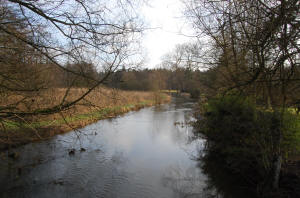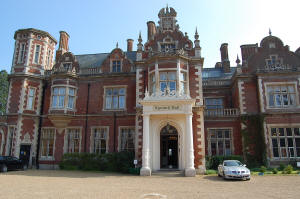River Wissey
'a river so secret that even its name
sounds like a whisper' - Roger Deakin
|
| Just to the west of the village of Shipdham lies an
important Norfolk watershed where three rivers: the Wissey,
the Yare and the Tud all have their origins.
The Yare heads eastwards, the Tud veers north-eastwards
and the Wissey heads off, via some fish ponds near Manor
Farm, towards the Fens.

River Wissey at
Ickburgh
Its first literary association lies in the village
of Bradenham - just a mile
or so from its source - where the river crosses a
ford
close to Bradenham Hall which was the birthplace of Sir
Henry Rider Haggard and also provided the inspiration
for Brandham Hall in L.P. Hartley's novel The
Go-Between.
From here the river heads south-westerly passing
through the villages of North and South Pickenham before
entering the STANTA battle training area. In the Battle
Area it is swollen by a stream from Thompson Water and
Stanford Water - two of Breckland's pingo ponds which
were formed by melting ice. Emerging from the Battle
Area the Wissey passes close to Lynford Hall which was
used by David Croft as a location for his sitcoms:
Dad's Army, You Rang
My Lord? and 'Allo 'Allo.

Lynford Hall
Roger Deakin, author of Waterlog (1999) swam
in the River Wissey as part of his tour of Britain. He
parked near Ickburgh bridge and the book provides a
stunningly beautiful description of the river in
summertime:
|
| 'It was full of
fish and wild flowers, and, for all I knew, crayfish and
naiads, wonderfully remote from any sort of
civilisation. The banks were thick with purple
water-mint, forget-me-not, hawkbit, and clouds of yellow
brimstones and cabbage whites browsing on the purple
loosestrife along the banks. The water was polished,
deep green and gold, shining from its velvet bed of
crowfoot and fine gravel; it seemed quite out of time,
flowing as sweetly as the river in Millais' painting of
the drowned Ophelia, decked with wild flowers.' |
He swam to Didlington bridge - a mile downstream -
and delighted in the sense of isolation and remoteness.
In fact, Didlington is another of Norfolk's
deserted
villages.Another superb description of the river is
to be found in John Cowper Powys' novel A Glastonbury
Romance (1932). The novel, which is widely regarded
as Powys' best book begins in Norfolk (see
Northwold) and concerns John
Crow - who later moves to Glastonbury to work for the
mystic John Geard. The book explores Arthurian grail
legends. However, in one of the early chapters John
takes a trip down the river with his cousin Mary - who
he later marries. The writing is of extraordinary
quality:
|
|
'Past deep, muddy estuaries the boat shot forward, where
the marigolds grew so thick as to resemble heaps of
scattered gold, flung out for largesse from some royal
barge, past groups of tall lombardy poplars, their proud
tops bowing gently away from the wind, past long-maned
and long-tailed horses who rushed to look at them as
they shot by, their liquid eyes filled with entranced
curiosity, past little farm-houses with great, sloping
red roofs, past massive cattle-sheds tiled with those
large, curved, brick tiles so characteristic of East
Anglia, past sunlit gaps in majestic woods through whose
clearings tall, flint church towers could be seen in the
far distance past huge black windmills, their great arms
glittering in the sun as they turned, grinding white
flour for the people of Norfolk.....' |
Beyond Northwold, the river slips onto the flat fenland
before eventually merging with the
River Great Ouse. At
one time, the Wissey went as far west as Wisbech (which
took its name from the river) but over a period of
time the river altered its course. The early East
Anglian tribe - the Wissa - may also have taken their
name from the river.Finally - the Wissey may also
have been the model for the River Leem in Graham Swift's
wonderful book about a fenland family Waterland.
The Leem flows from the chalk hills of Norfolk and drops
down onto the Fens before joining the Great Ouse - just
like the Wissey.
|
|

